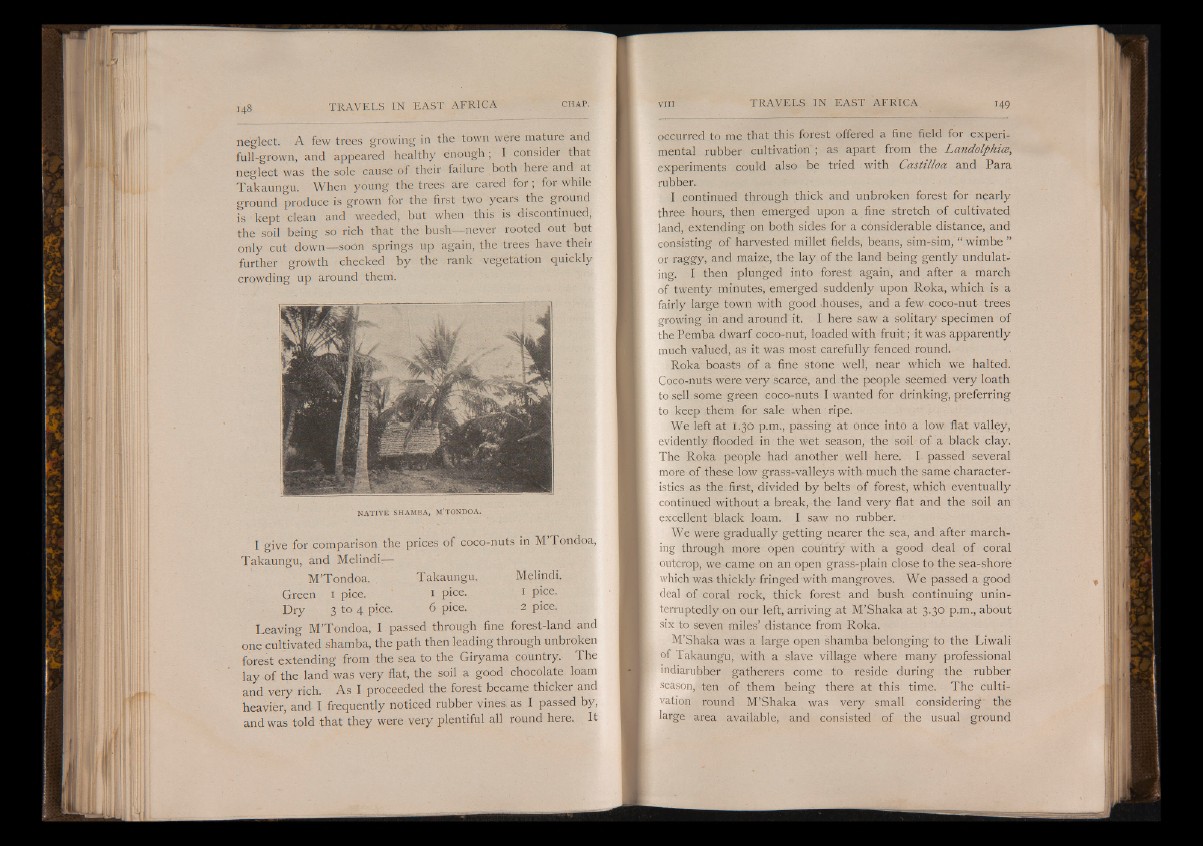
neglect. A few trees growing in the town were mature and
full-grown, and appeared healthy enough; I consider that
neglect was the sole cause of their failure both here and at
Takaungu. When young the trees are cared for; for while
ground produce is grown for the first two years the ground
is kept clean and weeded, but when this is discontinued,
the soil being so rich that the bush— never rooted out but
only cut down— soOn springs up again, the trees have their
further growth checked by the rank vegetation quickly
crowding up around them.
N A T IV E SH AM B A , M’TONDOA*
I give for comparison the prices of coco-nuts in M Tondoa,
Takaungu, and Melindi-—-
M’Tondoa. Takaungu. MelindL
Green i pice. ' i pice. i pice.
Dry 3 to 4 pice. 6 pice. 2 pice.
Leaving M’Tondoa, I passed through fine forest-land and
one cultivated shamba, the path then leading through unbroken
forest extending from the sea to the Giryama country. The
lay of the land was very flat, the soil a good chocolate loam
and very rich.. As I proceeded the forest became thicker and
heavier, and I frequently noticed rubber vines, as I passed by,
and was told that they were very plentiful all round here. It
occurred to me that this forest offered a fine field for experimental
rubber cultivation ; as apart from the Landolphice,
experiments could also be tried with Castilloa and Para
rubber.
I continued through thick and unbroken forest for nearly
three hours, then emerged upon a fine stretch of cultivated
land, extending on both sides for a considerable distance, and
consisting of harvested millet fields, beans, sim-sim, “ wimbe ”
or raggy, and maize, the lay of the land being gently undulating.
I then plunged into forest again, and after a march
of twenty minutes, emerged suddenly upon Roka, which is a
fairly large town with good .houses, and a few coco-nut- trees
growing in and around it. I here saw a solitary specimen of
the Pemba dwarf coco-nut, loaded with fruit; it was apparently
much valued, as it was most carefully fenced round.
Roka boasts of a fine stone well, near which we halted.
Coco-nuts were very scarce, and the people seemed very loath
to sell some green coco-nuts I wanted for drinking, preferring
to keep them for sale when ripe.
We left at 1.30 p.m., passing at once into a low flat valley,
evidently flooded in the wet season, the soil of a black clay.
The Roka people had another well here. I passed several
more of these low grass-valleys with much the same characteristics
as the first, divided by belts of forest, which eventually
continued without a break, the land very flat and the soil an
excellent black loam. I saw no rubber.
We were gradually getting nearer the sea, and after marching
through more open country with a good deal of coral
outcrop, we came on an open grass-plain close to the sea-shore
which was thickly fringed with mangroves. We passed a good
deal of coral rock, thick forest and bush continuing uninterruptedly
on our left, arriving at M’Shaka at 3.30 p.m., about
six to seven miles’ distance from Roka.
M’Shaka was a large open shamba belonging to the Liwali
of. Takaungu, with a slave village where many professional
indiarubber gatherers come to reside during the rubber
season, ten of them being there at this time. The cultivation
round M’Shaka was very small considering' the
large area available, and consisted of the usual ground